Shuai Han
Joint Antenna Positioning and Beamforming for Movable Antenna Array Aided Ground Station in Low-Earth Orbit Satellite Communication
Sep 09, 2025Abstract:This paper proposes a new architecture for the low-earth orbit (LEO) satellite ground station aided by movable antenna (MA) array. Unlike conventional fixed-position antenna (FPA), the MA array can flexibly adjust antenna positions to reconfigure array geometry, for more effectively mitigating interference and improving communication performance in ultra-dense LEO satellite networks. To reduce movement overhead, we configure antenna positions at the antenna initialization stage, which remain unchanged during the whole communication period of the ground station. To this end, an optimization problem is formulated to maximize the average achievable rate of the ground station by jointly optimizing its antenna position vector (APV) and time-varying beamforming weights, i.e., antenna weight vectors (AWVs). To solve the resulting non-convex optimization problem, we adopt the Lagrangian dual transformation and quadratic transformation to reformulate the objective function into a more tractable form. Then, we develop an efficient block coordinate descent-based iterative algorithm that alternately optimizes the APV and AWVs until convergence is reached. Simulation results demonstrate that our proposed MA scheme significantly outperforms traditional FPA by increasing the achievable rate at ground stations under various system setups, thus providing an efficient solution for interference mitigation in future ultra-dense LEO satellite communication networks.
MAGI-1: Autoregressive Video Generation at Scale
May 19, 2025Abstract:We present MAGI-1, a world model that generates videos by autoregressively predicting a sequence of video chunks, defined as fixed-length segments of consecutive frames. Trained to denoise per-chunk noise that increases monotonically over time, MAGI-1 enables causal temporal modeling and naturally supports streaming generation. It achieves strong performance on image-to-video (I2V) tasks conditioned on text instructions, providing high temporal consistency and scalability, which are made possible by several algorithmic innovations and a dedicated infrastructure stack. MAGI-1 facilitates controllable generation via chunk-wise prompting and supports real-time, memory-efficient deployment by maintaining constant peak inference cost, regardless of video length. The largest variant of MAGI-1 comprises 24 billion parameters and supports context lengths of up to 4 million tokens, demonstrating the scalability and robustness of our approach. The code and models are available at https://github.com/SandAI-org/MAGI-1 and https://github.com/SandAI-org/MagiAttention. The product can be accessed at https://sand.ai.
Credit Assignment and Efficient Exploration based on Influence Scope in Multi-agent Reinforcement Learning
May 13, 2025Abstract:Training cooperative agents in sparse-reward scenarios poses significant challenges for multi-agent reinforcement learning (MARL). Without clear feedback on actions at each step in sparse-reward setting, previous methods struggle with precise credit assignment among agents and effective exploration. In this paper, we introduce a novel method to deal with both credit assignment and exploration problems in reward-sparse domains. Accordingly, we propose an algorithm that calculates the Influence Scope of Agents (ISA) on states by taking specific value of the dimensions/attributes of states that can be influenced by individual agents. The mutual dependence between agents' actions and state attributes are then used to calculate the credit assignment and to delimit the exploration space for each individual agent. We then evaluate ISA in a variety of sparse-reward multi-agent scenarios. The results show that our method significantly outperforms the state-of-art baselines.
Unifying Physics- and Data-Driven Modeling via Novel Causal Spatiotemporal Graph Neural Network for Interpretable Epidemic Forecasting
Apr 07, 2025



Abstract:Accurate epidemic forecasting is crucial for effective disease control and prevention. Traditional compartmental models often struggle to estimate temporally and spatially varying epidemiological parameters, while deep learning models typically overlook disease transmission dynamics and lack interpretability in the epidemiological context. To address these limitations, we propose a novel Causal Spatiotemporal Graph Neural Network (CSTGNN), a hybrid framework that integrates a Spatio-Contact SIR model with Graph Neural Networks (GNNs) to capture the spatiotemporal propagation of epidemics. Inter-regional human mobility exhibits continuous and smooth spatiotemporal patterns, leading to adjacent graph structures that share underlying mobility dynamics. To model these dynamics, we employ an adaptive static connectivity graph to represent the stable components of human mobility and utilize a temporal dynamics model to capture fluctuations within these patterns. By integrating the adaptive static connectivity graph with the temporal dynamics graph, we construct a dynamic graph that encapsulates the comprehensive properties of human mobility networks. Additionally, to capture temporal trends and variations in infectious disease spread, we introduce a temporal decomposition model to handle temporal dependence. This model is then integrated with a dynamic graph convolutional network for epidemic forecasting. We validate our model using real-world datasets at the provincial level in China and the state level in Germany. Extensive studies demonstrate that our method effectively models the spatiotemporal dynamics of infectious diseases, providing a valuable tool for forecasting and intervention strategies. Furthermore, analysis of the learned parameters offers insights into disease transmission mechanisms, enhancing the interpretability and practical applicability of our model.
Sample Efficient Reinforcement Learning by Automatically Learning to Compose Subtasks
Jan 25, 2024Abstract:Improving sample efficiency is central to Reinforcement Learning (RL), especially in environments where the rewards are sparse. Some recent approaches have proposed to specify reward functions as manually designed or learned reward structures whose integrations in the RL algorithms are claimed to significantly improve the learning efficiency. Manually designed reward structures can suffer from inaccuracy and existing automatically learning methods are often computationally intractable for complex tasks. The integration of inaccurate or partial reward structures in RL algorithms fail to learn optimal policies. In this work, we propose an RL algorithm that can automatically structure the reward function for sample efficiency, given a set of labels that signify subtasks. Given such minimal knowledge about the task, we train a high-level policy that selects optimal sub-tasks in each state together with a low-level policy that efficiently learns to complete each sub-task. We evaluate our algorithm in a variety of sparse-reward environments. The experiment results show that our approach significantly outperforms the state-of-art baselines as the difficulty of the task increases.
On the Opportunities of Green Computing: A Survey
Nov 09, 2023



Abstract:Artificial Intelligence (AI) has achieved significant advancements in technology and research with the development over several decades, and is widely used in many areas including computing vision, natural language processing, time-series analysis, speech synthesis, etc. During the age of deep learning, especially with the arise of Large Language Models, a large majority of researchers' attention is paid on pursuing new state-of-the-art (SOTA) results, resulting in ever increasing of model size and computational complexity. The needs for high computing power brings higher carbon emission and undermines research fairness by preventing small or medium-sized research institutions and companies with limited funding in participating in research. To tackle the challenges of computing resources and environmental impact of AI, Green Computing has become a hot research topic. In this survey, we give a systematic overview of the technologies used in Green Computing. We propose the framework of Green Computing and devide it into four key components: (1) Measures of Greenness, (2) Energy-Efficient AI, (3) Energy-Efficient Computing Systems and (4) AI Use Cases for Sustainability. For each components, we discuss the research progress made and the commonly used techniques to optimize the AI efficiency. We conclude that this new research direction has the potential to address the conflicts between resource constraints and AI development. We encourage more researchers to put attention on this direction and make AI more environmental friendly.
Approaching epidemiological dynamics of COVID-19 with physics-informed neural networks
Feb 20, 2023



Abstract:A physics-informed neural network (PINN) embedded with the susceptible-infected-removed (SIR) model is devised to understand the temporal evolution dynamics of infectious diseases. Firstly, the effectiveness of this approach is demonstrated on synthetic data as generated from the numerical solution of the susceptible-asymptomatic-infected-recovered-dead (SAIRD) model. Then, the method is applied to COVID-19 data reported for Germany and shows that it can accurately identify and predict virus spread trends. The results indicate that an incomplete physics-informed model can approach more complicated dynamics efficiently. Thus, the present work demonstrates the high potential of using machine learning methods, e.g., PINNs, to study and predict epidemic dynamics in combination with compartmental models.
VCE: Variational Convertor-Encoder for One-Shot Generalization
Nov 12, 2020Abstract:Variational Convertor-Encoder (VCE) converts an image to various styles; we present this novel architecture for the problem of one-shot generalization and its transfer to new tasks not seen before without additional training. We also improve the performance of variational auto-encoder (VAE) to filter those blurred points using a novel algorithm proposed by us, namely large margin VAE (LMVAE). Two samples with the same property are input to the encoder, and then a convertor is required to processes one of them from the noisy outputs of the encoder; finally, the noise represents a variety of transformation rules and is used to convert new images. The algorithm that combines and improves the condition variational auto-encoder (CVAE) and introspective VAE, we propose this new framework aim to transform graphics instead of generating them; it is used for the one-shot generative process. No sequential inference algorithmic is needed in training. Compared to recent Omniglot datasets, the results show that our model produces more realistic and diverse images.
Proximal Policy Optimization via Enhanced Exploration Efficiency
Nov 11, 2020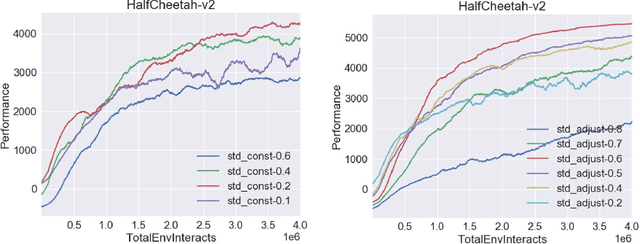

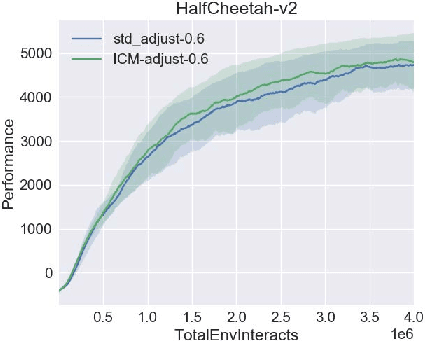
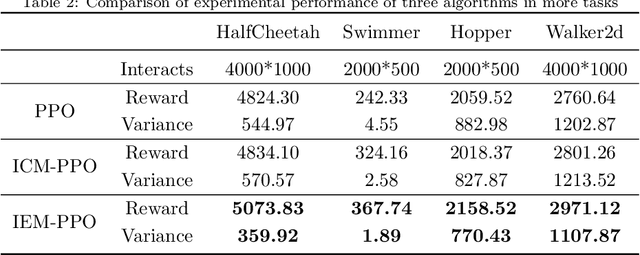
Abstract:Proximal policy optimization (PPO) algorithm is a deep reinforcement learning algorithm with outstanding performance, especially in continuous control tasks. But the performance of this method is still affected by its exploration ability. For classical reinforcement learning, there are some schemes that make exploration more full and balanced with data exploitation, but they can't be applied in complex environments due to the complexity of algorithm. Based on continuous control tasks with dense reward, this paper analyzes the assumption of the original Gaussian action exploration mechanism in PPO algorithm, and clarifies the influence of exploration ability on performance. Afterward, aiming at the problem of exploration, an exploration enhancement mechanism based on uncertainty estimation is designed in this paper. Then, we apply exploration enhancement theory to PPO algorithm and propose the proximal policy optimization algorithm with intrinsic exploration module (IEM-PPO) which can be used in complex environments. In the experimental parts, we evaluate our method on multiple tasks of MuJoCo physical simulator, and compare IEM-PPO algorithm with curiosity driven exploration algorithm (ICM-PPO) and original algorithm (PPO). The experimental results demonstrate that IEM-PPO algorithm needs longer training time, but performs better in terms of sample efficiency and cumulative reward, and has stability and robustness.
Regularly Updated Deterministic Policy Gradient Algorithm
Jul 01, 2020
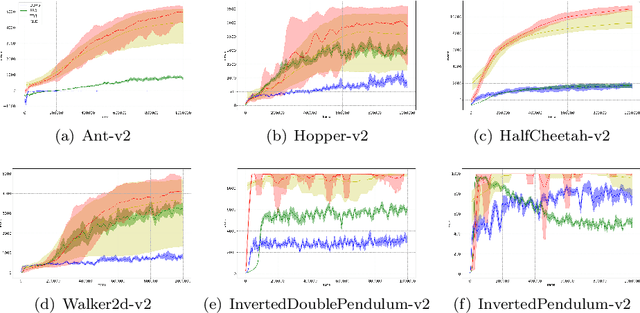
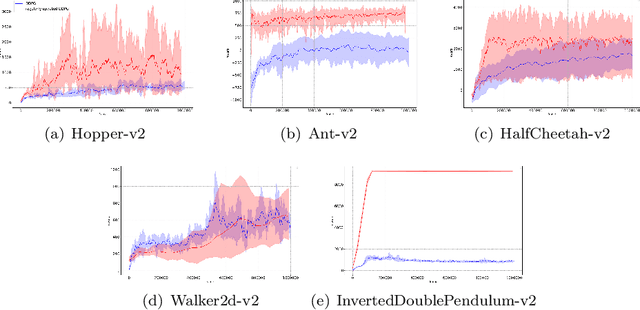
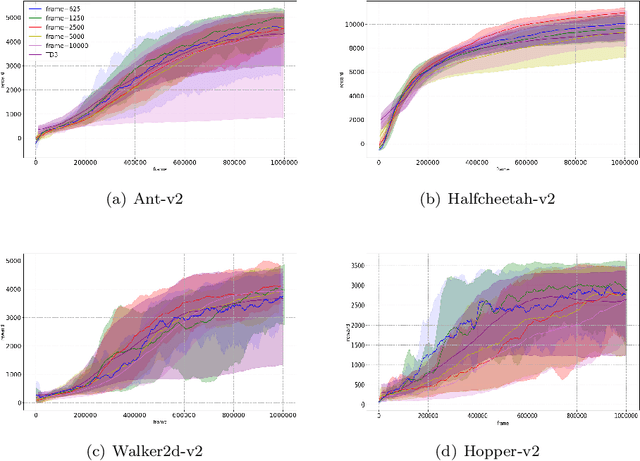
Abstract:Deep Deterministic Policy Gradient (DDPG) algorithm is one of the most well-known reinforcement learning methods. However, this method is inefficient and unstable in practical applications. On the other hand, the bias and variance of the Q estimation in the target function are sometimes difficult to control. This paper proposes a Regularly Updated Deterministic (RUD) policy gradient algorithm for these problems. This paper theoretically proves that the learning procedure with RUD can make better use of new data in replay buffer than the traditional procedure. In addition, the low variance of the Q value in RUD is more suitable for the current Clipped Double Q-learning strategy. This paper has designed a comparison experiment against previous methods, an ablation experiment with the original DDPG, and other analytical experiments in Mujoco environments. The experimental results demonstrate the effectiveness and superiority of RUD.
 Add to Chrome
Add to Chrome Add to Firefox
Add to Firefox Add to Edge
Add to Edge